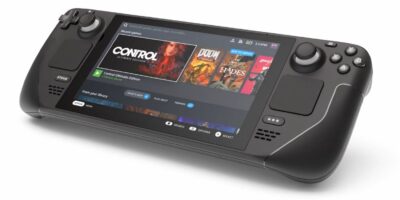
The Steam Deck is a handheld PC designed by Valve that looks like a Nintendo Switch but with high end PC components. However, given Valve’s track record concerning hardware (anyone remember the Steam Machine?), it remains to be seen whether the Steam Deck will be a new standard for the industry. Can the Steam Deck erode some of Nintendo’s dominance in the handheld market? Do they even want to? Who is the Steam Deck even for anyway? Read on to find out.
Is the Steam Deck Just a Fancy Nintendo Switch?
While the Valve Steam Deck shares some aesthetic similarities with the wildly successful Nintendo Switch, it is an entirely different beast. The Steam Deck is essentially a gaming PC crammed into a portable form factor.

The Nintendo Switch has been a runaway success. That being said, the console’s relatively weak hardware has left some fans clamoring for a more powerful version of the system. Unfortunately, the new iteration of the Switch OLED features the same internal hardware, just with a better screen.
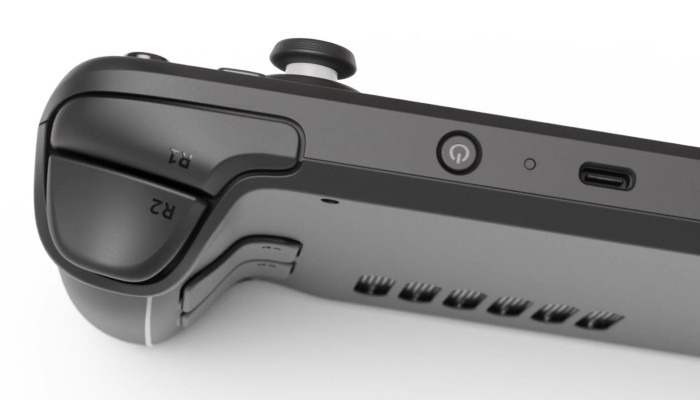
Valve is aiming to avoid such disappointments by making one of the most powerful handheld gaming machines ever seen. The Steam Deck is designed to run the latest AAA games – and run them well. Based on the specifications that Valve has released, it looks as though they’ll deliver on this promise.
Hardware Specifications
The Steam Deck will be released in three different configurations. That being said, all models will feature the same internal hardware – the difference being the storage capacity of each model.
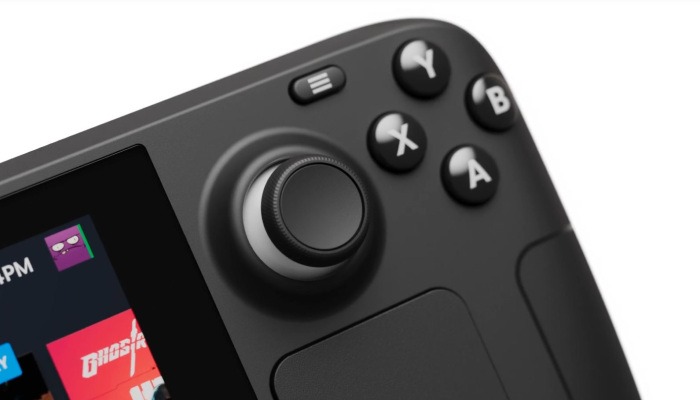
Processor: AMD APU
CPU: Zen 2 4c/8t, 2.4-3.5GHz (up to 448 GFlops FP32)
GPU: 8 RDNA 2 CUs, 1.0-1.6GHz (up to 1.6 TFlops FP32)
APU power: 4-15W
RAM: 16 GB LPDDR5 on-board RAM (5500 MT/s quad 32-bit channels)
Storage: 64 GB eMMC (PCIe Gen 2 x1)
256 GB NVMe SSD (PCIe Gen 3 x4)
512 GB high-speed NVMe SSD (PCIe Gen 3 x4)
Display: 1280 x 800px (16:10 aspect ratio) IPS LCD
7 inch diagonal
400 nits brightness
60 Hz refresh rate
Touch enabled
Connectivity: Bluetooth 5.0 (support for controllers, accessories and audio)
Dual-band Wi-Fi radio, 2.4GHz and 5GHz, 2 x 2 MIMO, IEEE 802.11a/b/g/n/ac
Audio: Stereo with embedded DSP for an immersive listening experience
Dual microphone array
3.5mm stereo headphone / headset jack
Power: 45W USB Type-C PD3.0 power supply
40Whr battery. Approx. two to eight hours of gameplay
Size: 298mm x 117mm x 49mm
Approx. 669 grams
Design
The Steam Deck bears a striking similarity to the Nintendo Switch. It’s a handheld console that has built-in controls and screen; however, Valve is promising some extra tricks up the Steam Deck’s sleeve.
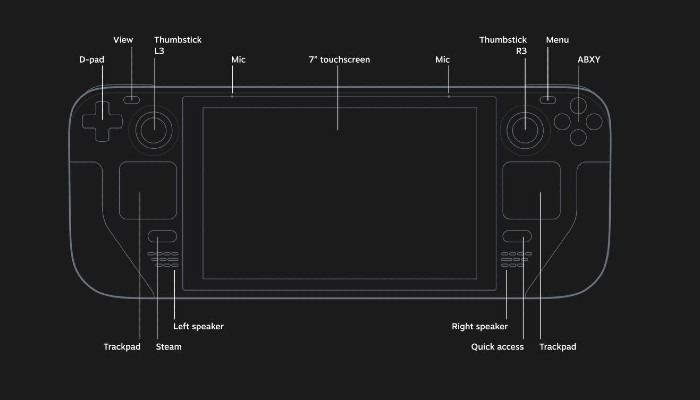
The first thing we should note is that the Steam Deck does not have removable Joy-Cons like the Nintendo Switch. Instead, it is an all-in-one unit. The front of the device features the 7″ screen, a D-Pad, two analog sticks, two trackpads, and the familiar diamond A, B, X, Y face button layout. On the top of the device are left and right shoulder and trigger buttons. Finally, on the back of the Steam Deck, there are four user-assignable buttons. These are placed on the underside of the left and right grips, enabling access without having to remove their thumbs from the trackpads or analog sticks.
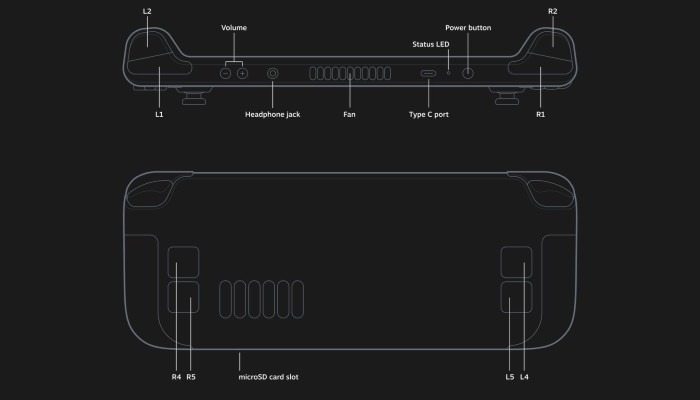
With all of the controversy surrounding controllers and “stick drift,” Valve has made sure to placate consumer fears by ensuring excellent build quality. The analog thumbsticks boast built-in capactive touch sensors which, according to Valve, provide unparalleled accuracy. In addition, the Steam Deck also features two trackpads located underneath each analog stick. These enable users to play PC games that weren’t designed for a controller. The trackpads are also customizable, allowing users increased precision when playing games that normally benefit from a mouse, such as CS:GO.
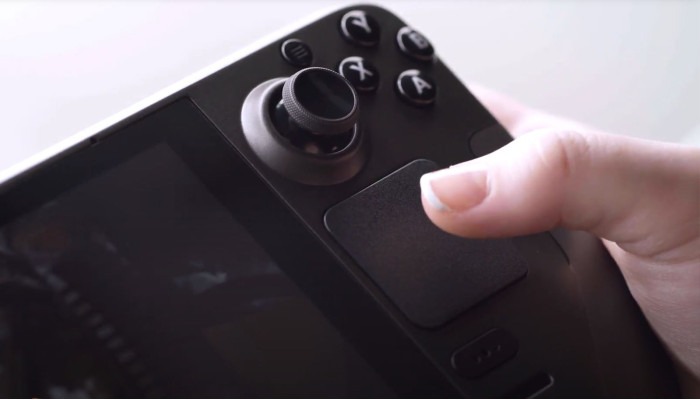
Finally, the Steam Deck also features a capacitive multi-touch display. This allows quick navigation of the SteamOS user interface and enables the use of an on-screen keyboard.
Inputs/Outputs
On the bottom of the Steam Deck there is a microSD slot. This allows users to expand the Steam Deck’s storage capacity. This can be a lifesaver, as modern games can be huge, leaving users spending more time engaging in storage management as opposed to gaming. Any games that are stored on the microSD card will automatically appear in the Steam Deck’s game library.
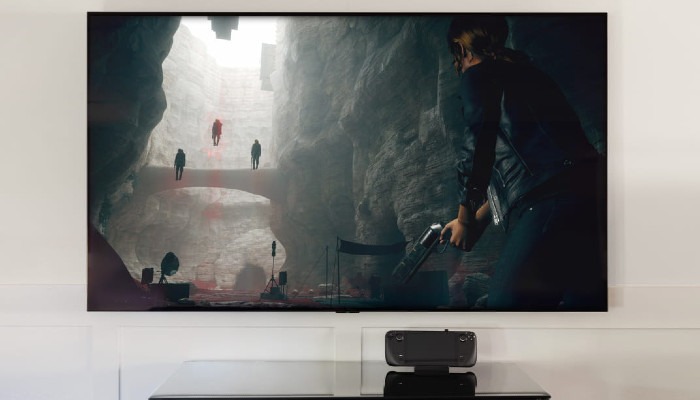
The Steam Deck also boasts a multi-function USB-C port. The USB-C port can be used to charge the Steam Deck and connect peripherals like a USB-C hub, controllers, or even a mouse and keyboard. Furthermore, the USB-C port can be used to connect the Steam Deck to a TV, allowing users to play games on the big screen.
The Steam Deck also has Bluetooth connectivity, allowing users to connect controllers, keyboards, mice and headphones/headsets wirelessly.
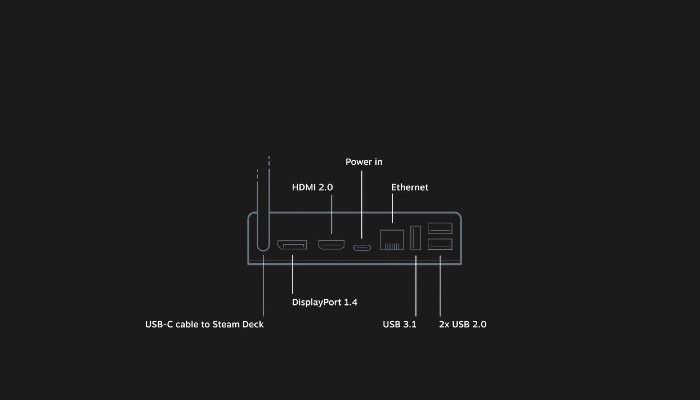
Valve has developed an official dock for the Steam Deck. Much like the dock for the Nintendo Switch, the official Steam Deck dock allows users to connect their system to a TV while propping it up. Furthermore, it will provide additional connectivity options. This includes an Ethernet port for wired networking, three USB ports, a DisplayPort and USB-C for passthrough power delivery. Unfortunately, there is no word when the dock will be available or how much it will cost.
Operating System
The Steam Deck runs SteamOS, a Linux-based operating system. Valve’s previous foray into console gaming, the Steam Machine, also used SteamOS. This version of SteamOS has been built from the ground up for the Steam Deck. Known as SteamOS 3.0, the operating system has been designed to optimize the handheld gaming experience.
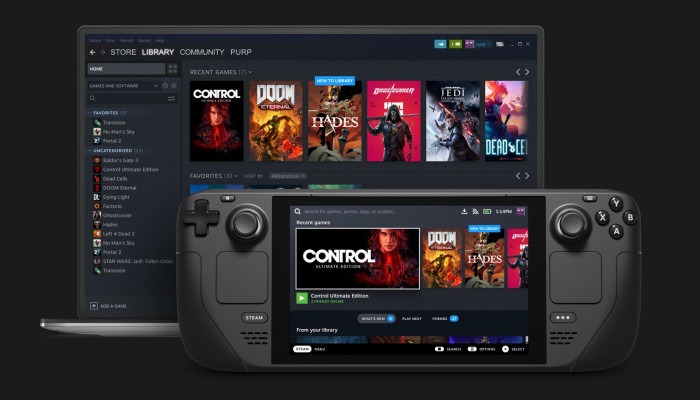
Furthermore, it comes integrated with Proton, a compatibility layer. Normally, developers would have to port their games to a new OS/hardware configuration. However, Proton makes it possible for all of your games to run on the Steam Deck without a lengthy porting process. This means your entire Steam library will be available on the Steam Deck from the day you fire it up.

While the Steam Deck has been designed primarily as a gaming machine, it is still a PC at heart. This means you’ll be able to do a variety of things you can’t do on the average gaming console. This includes installing third-party software, stream media, and even installing other shopfronts like Xbox Game Pass or the Epic Store. You could even potentially install an entirely new operating system if you wanted to.
Games and Performance
Valve has stated that they want the Steam Deck to run every game available in the Steam library. They’ve gone on record saying that so far, the Steam Deck has managed to run everything that the development team has thrown at it. While Valve is claiming that that Steam Deck is a powerhouse PC in the palm of your hand, it’s tough to know for sure until the unit becomes available. That being said, we can speculate.
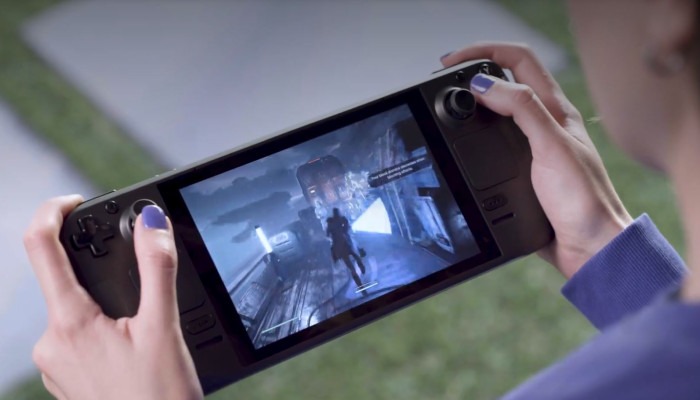
Under the hood, the Steam Deck runs an AMD APU: a hybrid CPU/GPU. While some outlets have been trying to find comparisons to existing hardware, there really isn’t an exact match.
However, there are a few things to keep in mind. Valve is claiming that the Steam Deck can get anywhere from two to eight hours of gameplay. This isn’t fantastic, but it’s safe to say that in order to squeeze more gameplay time, you’re probably going to have to sacrifice clock speeds, resolutions and framerates. So while the Steam Deck may certainly be capable of running a game, it may only be playable with lower settings applied.

We can definitively say that load times will differ greatly depending on which model you go for. The base model is using eMMC storage, which is significantly slower than the NVMe storage that the other models use. So if you can afford it, opt for one of the more expensive models for a better overall experience.
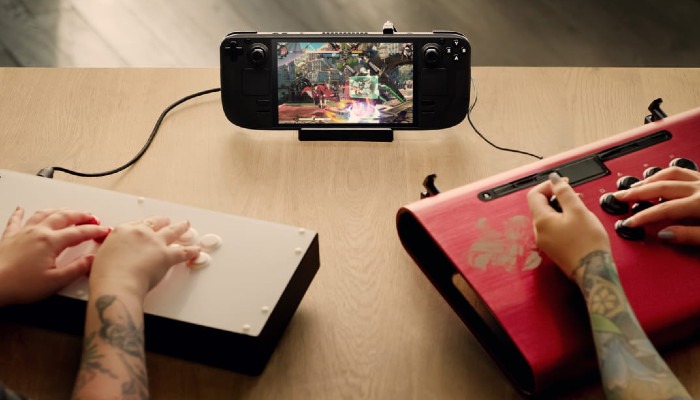
The other elephant in the room is the fact that the Steam Deck runs SteamOS, a version of Linux. This means Windows-based games may not be playable on the Steam Deck – at least not yet. We mentioned above that the Steam Deck utilizes Proton, which aims to minimize compatibility issues. How effective Proton’s implementation is remains to be seen.
Cost
The price of the Steam Deck depends on which model you opt for. As we mentioned earlier, the hardware specs of each model are all the same, except for the storage. The three models available are:
- $399 for the 64 GB version
- $529 for the 256 GB version
- $649 for the 512 GB version
Note: while the 256 and 512 GB versions both use NVMe SSD storage, the 64 GB version uses eMMC.
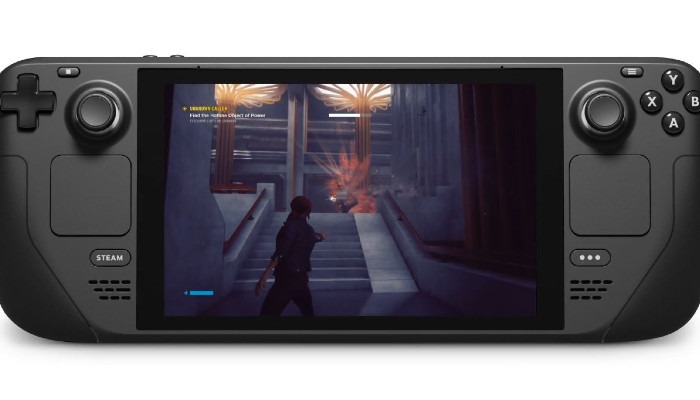
All three versions of the Steam Deck use socketed 2230 m.2 modules. Valve has stated that these storage units are not designed to be replaced by the end user. That being said, all models have a high speed MicroSD card slot which will allow users to expand the storage capacity of their unit. If you plan on using a microSD card, we recommend using the fastest card you can afford. Using a slower card can negatively impact things like load times.
Release Date
The Steam Deck will be released in December 2021. However, this is only in certain regions, including the United States, Canada, the European Union and the United Kingdom. Valve has not provided any information about availability in other regions; however, they claim that further details will be coming soon.

It is important to note that even though Valve claims that the Steam Deck will start shipping in December 2021, it is not making any guarantees. At this stage, there is a reservation process, which essentially puts customers in a queue. As inventory becomes available, those in the queue will have their orders fulfilled.
Before You Buy
The Steam Deck is an enticing bit of hardware. It’s certainly something that hardcore gamers have been asking for. That being said, there are a number of potential drawbacks.
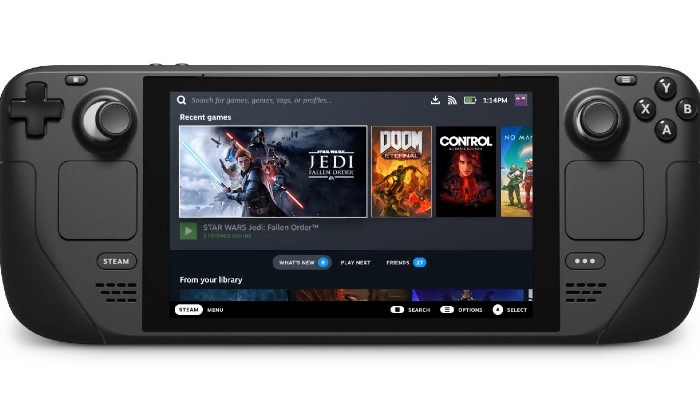
The first is it’s compatibility with Windows-only games. While the Steam library is massive, there are a number of games that are wildly popular that currently only run on Windows-based PCs. These titles include, but are certainly not limited to, Rainbow Six Siege, Destiny 2 and Apex Legends.
As we mentioned before, the Proton software is supposed to fix compatibility issues; however, that’s not Valve’s only obstacle. Games that use anti-cheat software are incompatible with Linux – meaning gamers would be unable to log in to multiplayer servers. Valve claims these problems will be resolved before launch. However, it is still cause for concern.
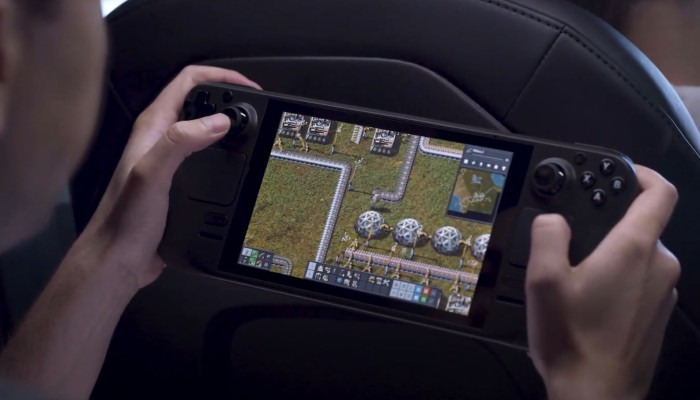
The other major issue is the battery life. Valve claims the Steam Deck’s internal battery will get anywhere from two to eight hours of gameplay before it needs to be recharged. Valve hasn’t released any further information, but it’s safe to say that more demanding games will drain the battery faster. Older gamers will undoubtedly have flashbacks to the Sega Game Gear days when they churned through six AA batteries with shocking regularity.
Wrapping Up
The Steam Deck has certainly garnered a lot of attention since its announcement. On paper the device appears to tick a lot of boxes. However, it is important to remember that Valve’s last foray into hardware, the Steam Machine, was a giant flop. We’re not saying that the Steam Deck will have the same fate, but it’s always smart to taper expectations. This is especially true for something that no one has had their hands on yet.
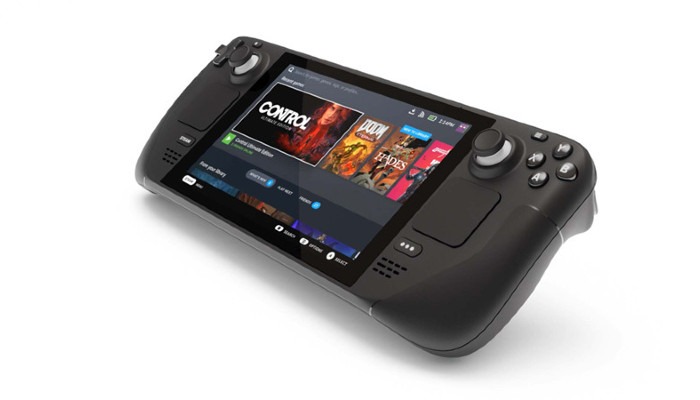
That being said, the prospect of playing AAA PC games on the go or while lying in bed is cause for celebration. Furthermore, the impressive hardware should enable the Steam Deck to deliver on some of the loftier performance promises. Additionally, if the Steam Deck is indeed compatible with the entire Steam library, there will be no shortage of games. The price point is also something of note: the fact that the Steam Deck will be relatively affordable is nothing short of wizardry on Valve’s part.
Do you plan on purchasing the Steam Deck? Why or why not? Let us know in the comments! Read on to learn how to play Steam games on your phone with Steam Link and use Steam Play to play Windows games on Linux.